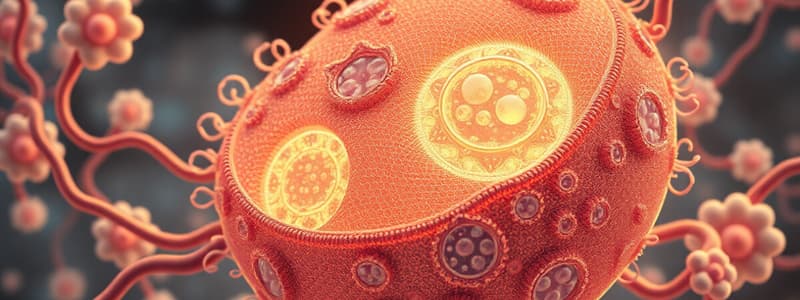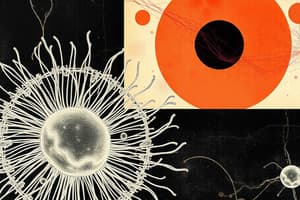Podcast
Questions and Answers
What role do lysosomes play in cellular function?
What role do lysosomes play in cellular function?
- Energy production
- Photosynthesis
- Storing genetic information
- Digesting old cell parts (correct)
Which statement accurately describes chloroplasts?
Which statement accurately describes chloroplasts?
- They are involved in cellular respiration.
- They capture light energy for photosynthesis. (correct)
- They are responsible for RNA synthesis.
- They consist of a single membrane.
How do cilia and flagella differ in their function?
How do cilia and flagella differ in their function?
- Cilia can only function in plant cells.
- Flagella are shorter and used for feeding.
- Flagella are the primary means of nutrient absorption.
- Cilia move in coordinated waves; flagella move like a propeller. (correct)
What is the primary structure surrounding the nucleus?
What is the primary structure surrounding the nucleus?
What component primarily makes up the cell wall in plants?
What component primarily makes up the cell wall in plants?
What is the primary function of the Rough Endoplasmic Reticulum?
What is the primary function of the Rough Endoplasmic Reticulum?
What structure serves as the mechanical boundary and selectively permeable barrier of the eukaryotic cell?
What structure serves as the mechanical boundary and selectively permeable barrier of the eukaryotic cell?
Which component of the cytoskeleton is primarily responsible for mechanical support and anchoring organelles?
Which component of the cytoskeleton is primarily responsible for mechanical support and anchoring organelles?
What characteristic defines eukaryotic cells as opposed to prokaryotic cells?
What characteristic defines eukaryotic cells as opposed to prokaryotic cells?
What is the role of ribosomes in eukaryotic cells?
What is the role of ribosomes in eukaryotic cells?
Study Notes
Eukaryotic Cells Overview
- Eukaryotic cells belong to the Domain Eukarya, which includes Protists, Fungi, Plants, and Animals.
- Characterized by membrane-bound nucleus, specialized organelles, and plasma membrane.
Plasma Membrane
- Composed of a double layer of phospholipids and proteins.
- Acts as a mechanical boundary, selectively permeable barrier regulating materials entering and leaving the cell.
- Facilitates cell-cell interactions.
Cytoplasm
- A viscous fluid (cytosol) containing organelles, ensconced within the plasma membrane.
- Made up of interconnected filaments and fibers.
Cytoskeleton
- Comprised of filaments and fibers organized into three types: microfilaments, microtubules, and intermediate filaments.
- Provides mechanical support and anchors organelles.
Endoplasmic Reticulum (ER)
- Rough ER is studded with ribosomes, playing a crucial role in protein synthesis and modification (e.g., glycoprotein formation).
- Smooth ER is involved in lipid synthesis (phospholipids, steroids), carbohydrate metabolism (glycogen), and detoxification of drugs and poisons.
Ribosomes
- Essential for protein synthesis, made of rRNA with a large and small subunit produced in the nucleolus.
- Located either on the rough ER or free in the cytoplasm, existing individually or as polyribosomes.
Golgi Apparatus
- Composed of 3-20 flattened, curved saccules resembling stacks of pancakes.
- Modifies proteins and lipids, packaging them into vesicles for transport within the cell.
Lysosomes
- Contain digestive enzymes for intracellular digestion.
- Aid in cell renewal and breakdown of old cellular components.
Mitochondria
- Function as the powerhouses of the cell, producing energy via the tricarboxylic acid cycle, electron transport, and oxidative phosphorylation.
- Surrounded by a double membrane, consisting of infoldings (cristae) enclosing a semifluid matrix.
Chloroplasts
- Organelles responsible for photosynthesis, capturing light energy to synthesize carbohydrates from CO2 and H2O.
- Convert energy-poor compounds into energy-rich ones.
Nucleus
- Acts as the control center and genetic information repository of the cell.
- Enclosed by a double-layered nuclear envelope, with pores allowing exchange between nucleoplasm and cytoplasm.
Nucleolus
- Often has two or more per cell; directs RNA synthesis and ribosomal RNA construction.
Cell Wall
- A carbohydrate framework providing mechanical support, differing among organisms: cellulose in plants, chitin in fungi, and varying structures in bacteria and protists.
- Strengthens and shapes the cell.
Cilia and Flagella
- Hair-like projections aiding in cell movement, utilizing a 9 + 2 microtubule arrangement.
- Cilia are short and move in coordinated waves, while flagella are longer and propel the cell in a corkscrew motion.
Vacuoles
- Membrane-bound storage sacs that hold excess materials such as water, nutrients, pigments, and waste.
- Play a role in developing turgor pressure crucial for plant cell structure.
Studying That Suits You
Use AI to generate personalized quizzes and flashcards to suit your learning preferences.
Related Documents
Description
Explore the fascinating world of eukaryotic cells, the smallest living units that form the basis of life in organisms such as plants, animals, fungi, and protists. This quiz covers essential features including membrane-bound nuclei, organelles, and the plasma membrane. Test your knowledge on the various functions and structures that define these complex cells.




